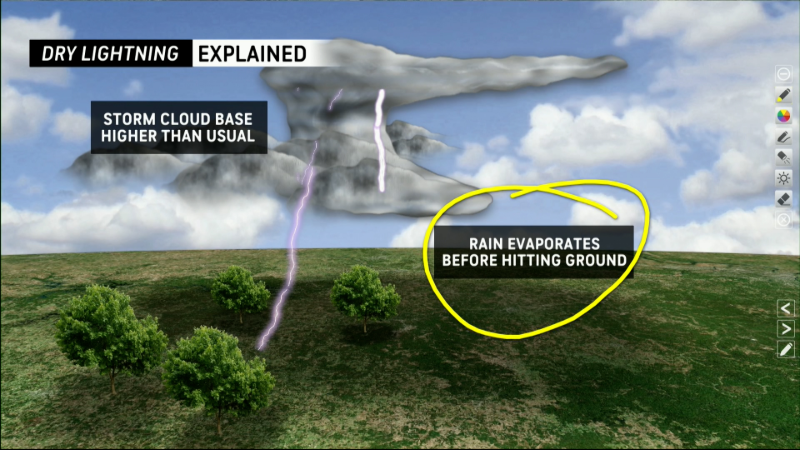Snowboarder killed in Colorado as avalanche danger mounts
There have been 14 avalanche deaths nationwide this winter. Learning about avalanches will help you decide when, where, and how to visit the backcountry with the odds stacked in your favor.
This bodycam footage from the Summit County Sheriff’s Office in Colorado shows the rescue of a man that was buried after an avalanche on Feb. 17. The man was dug out and sustained minor injuries.
A snowboarder was killed in Colorado on Saturday, Feb. 22, after an avalanche buried him. It happened on Mines Peak, east of Berthoud Pass, in an area locally known as The Fingers or High Trail Cliffs, according to the Colorado Avalanche Information Center (CAIC). This was a large, persistent slab avalanche, which forms when a persistent weak layer is buried by additional layers of snow.
"The persistent weak layer can cycle through periods of sensitivity from reactive to nonreactive due to changes in weather conditions such as new precipitation, wind loading, strong solar radiation, and/or rapid changes in air temperature," CAIC noted.

Looking uphill at the avalanche that killed a backcountry rider on Feb. 22, 2025. The avalanche broke into old snow layers and removed the entire season's snowpack in the area. (Photo credit: Colorado Avalanche Information Center)

A photo of The Fingers avalanche path on Mines Peak, east of Berthoud Pass where a snowboarder was caught and killed on Feb. 22. (Photo credit: Colorado Avalanche Information Center)
The snowboarder's death comes as the third avalanche-related fatality of the 2024-2025 winter season in Colorado and the 14th death nationwide, according to the National Avalanche Center. Last winter season, there were 16 avalanche deaths in the United States.
Last week a couple skiing together in Oregon on Monday were killed when an avalanche buried them in an area west of Bend, the Deschutes County Sheriff's Office said.
Avalanches kill more people in National Forests than any other natural hazard, according to CAIC. Each winter, 25 to 30 people die in avalanches in the U.S., and nearly all of these deaths occur in National Forests.
AccuWeather’s Melissa Constanzer shares which activities make you more likely to be caught in an avalanche.
Some days are dangerous and some days are not. Learning about avalanches will help you decide when, where, and how to visit the backcountry.
"Avalanches don't discriminate, they're equal opportunity killers and they affect everyone in the mountains," pro snowboarder Travis Rice told the National Avalanche Center. "Whether you're snowboarding, skiing, snowmobiling, sledding, cross-country skiing, hiking, snowshoeing, extreme snow-angeling, if you live close to snow and mountains, you need to know about avalanches, it really just goes with the territory."
There are many different kinds of avalanches, but the ones that cause the most trouble are called dry slab avalanches.
"A slab avalanche is like a monster in a horror film. It lies underneath the perfect facade of this enticing power and it's just waiting for a trigger to come along, like you, to collapse that weak layer and then that collapse just goes outward in all directions, shatters like a pane of glass. There's no escape, it rockets down the hill, bounces you off trees and rocks on the way down, tumbles you off a cliff," said Bruce Tremper with the Utah Avalanche Center.
Avalanches are very violent deaths, Tremper added, noting that one out of four people is killed by the trauma of hitting trees and rocks on the way down. "After they tumble you to the bottom the avalanche instantly sets up like concrete, you can't just pop up out of them. Somebody has to dig you out of the snow."
The most important skill to learn before heading out in the snow is how to read avalanche terrain, which mainly means judging slope steepness. "Almost all avalanches occur on slopes steeper than 30 degrees." Tremper explained. "The bottom line is the only time we want to even consider getting on steep terrain is when we have safe avalanche conditions.
While ski resorts routinely conduct avalanche control, the backcountry is an uncontrollable environment and can be very dangerous, so you need to be your own avalanche expert. Learning about avalanche safety, as well as the necessary gear, can be overwhelming, but remember, it doesn’t matter if you have made thousands of good calls; all it takes is one bad call, and that's one too many.
"Five basic things can prevent most avalanche accidents," Rice said. "Get the gear, get the training, get the forecast, get the picture and get out of harm's way."
GET THE FREE ACCUWEATHER APP
•Have the app? Unlock AccuWeather Alerts™ with Premium+
Basic rescue gear includes an avalanche transceiver, a shovel and a probe. Experts say you should regularly practice using this gear because if your friend gets caught in an avalanche they only have 15 minutes to survive buried beneath the snow.
The North American Avalanche Danger Scale is a five-level scale used to communicate the danger of avalanches to backcountry recreationists. The danger is a combination of the expected likelihood, size, and distribution of avalanches.

In addition to always checking the weather and the avalanche forecast before you go, pay attention to recent snowfall, wind events, and temperature changes as these can significantly impact avalanche risk. If the forecast indicates high danger, adjust your route, choose less steep terrain, or postpone your trip altogether.
The northwestern U.S. is facing yet another storm this week that will bring a swath of heavy rain, wind and mountain snow. The risk for river flooding, avalanches and mudslides will remain high, AccuWeather meteorologists warn.
Report a Typo















